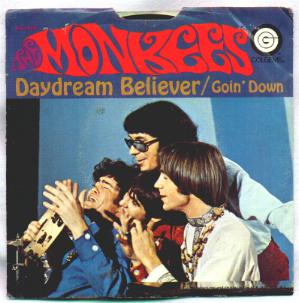February 12, 2021 —– Chart #78
Hello Musical Friends,
Did you miss me on Friday? Just got busy and did not manage to get my Chart of the Day out on time this week. So we will make this a Sunday edition of your Friday Chart of the Day. Maybe I was daydreaming on Friday!
So for today’s selection we go to 1967. “Daydream Believer” is a song composed by American songwriter John Stewart, shortly before he left the Kingston Trio. It was originally recorded by the Monkees, with Davy Jones singing the lead. The single reached No. 1 on the U.S. Billboard Hot 100 chart in December 1967, remaining there for four weeks, and peaked at No. 5 in the UK Singles Chart. It was the Monkees’ last No. 1 hit in the U.S.
In 1979, “Daydream Believer” was recorded by Canadian singer Anne Murray, whose version reached No. 3 on the U.S. country singles chart and No. 12 on the Billboard Hot 100. The song has been recorded by others, including a 1971 version by Stewart himself.
John Stewart wrote “Daydream Believer” as the third in a trilogy of songs about suburban life, recalling: “I remember thinking, “What a wasted day — all I’ve done is daydream”. And from there I wrote the whole song. I never thought it was one of my best songs. Not at all”. According to Variety, the song’s lyrics focus on the endgame of a comfy but increasingly distant relationship, with the narrator “caught in mid-gaze before the bathroom mirror, reflecting on the quiet dissolution of his materialistic marriage – a union between “a daydream believer and a homecoming queen,” now curdled, driven more by money than by romance”. The song was turned down by We Five and Spanky and Our Gang. While attending a party at Hoyt Axton’s home in Hollywood’s Laurel Canyon, producer Chip Douglas told Stewart that he was now producing the Monkees and asked if Stewart had any songs that might work for the group. Stewart offered “Daydream Believer”. The song was recorded during the sessions for the Monkees’ 1967 album Pisces, Aquarius, Capricorn & Jones Ltd., but was ultimately included on their 1968 album, The Birds, The Bees & the Monkees. All four Monkees appear on the track: in addition to the lead vocals by Jones, Michael Nesmith appears on lead guitar, Peter Tork on piano and Micky Dolenz on backing vocals. Tork created the piano introduction, and the orchestral arrangement was created by jazz trumpeter and composer Shorty Rogers, who included the same seven-note phrase preceding the chorus that can be heard on the Beach Boys’ “Help Me, Rhonda”.
The track begins with this spoken dialogue:
Chip Douglas: 7A…
Davy Jones: What number is this, Chip?
Douglas (and another unspecified voice): SEVEN – A!
Jones: Okay, I don’t mean to get you excited, man. It’s ’cause I’m short, I know…
Jones claimed he had been “pissed off” recording the song, with his lead vocal showing a hint of annoyance at the ongoing takes.
According to Billboard Hot 100 chart historian Joel Whitburn’s mid-1980s book The Billboard Book of Number One Hits, the recording was originally scheduled to be the B-side of the Barry Mann/Cynthia Weil song “Love Is Only Sleeping” (from Pisces, Aquarius, Capricorn & Jones Ltd.), featuring lead vocals by Michael Nesmith. However, a week before release, it was discovered that the European single masters for “Love Is Only Sleeping” were not ready, but the masters for “Daydream Believer” were. A last-minute switch meant that “Daydream Believer” now became the A-side and “Goin’ Down”, a song written by all four Monkees with Diane Hildebrand, in the style of Mose Allison, became the flip side. As such, Nesmith would not be given a lead vocal on a Monkees’ single A-side until 1969’s “Listen to the Band”. Allegedly, Colgems Records did not like Nesmith’s voice, preferring the voices of both Dolenz and Jones, and was further aggrieved when Nesmith had insisted on the inclusion of at least two of his songs per album. Previously, Nesmith’s lead vocal version of “The Girl I Knew Somewhere” had been eschewed for a re-recording with Dolenz on lead vocals for the B-side of the single “A Little Bit Me, a Little Bit You”.
RCA Records did not like the song as written by Stewart, and insisted on changing a critical word. Stewart originally wrote “Now you know how funky I can be,” but RCA wanted to change it to “Now you know how happy I can be,” as one meaning of “funky” is “smelly”. Stewart initially objected because the change would completely reverse the meaning of the line and would not make sense in the context of the song. He relented because RCA was adamant and Stewart realized that the song could well be a hit. In 2006, Stewart said that the proceeds from “Daydream Believer” “…kept me alive for all these years.”
In 1986, three of the four Monkees (Dolenz, Jones and Tork) mounted a successful reunion tour and had a major hit with the newly recorded “That Was Then, This Is Now”. Arista Records, which owned the Monkees’ masters at the time, re-released “Daydream Believer” as a follow-up single, remixed with a new and heavier percussion track by Michael Lloyd, who had produced “That Was Then, This Is Now”.
And if you are curious, here is Anne Murray’s version: https://youtu.be/AHc1Gbu5-20
And the author John Stewart performing his song: https://youtu.be/4aG0pG4W-NI
Keep rockin’ my friends,
Stan
